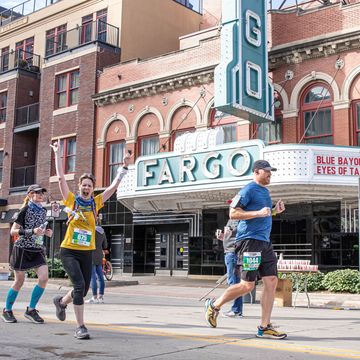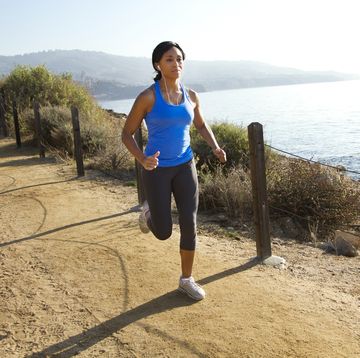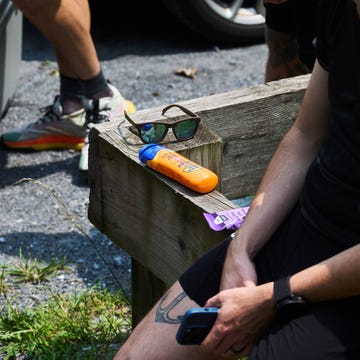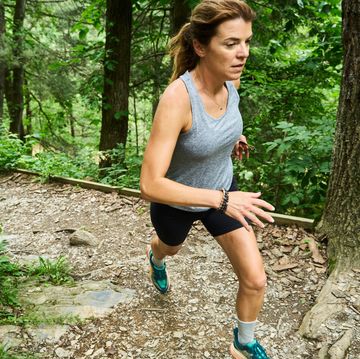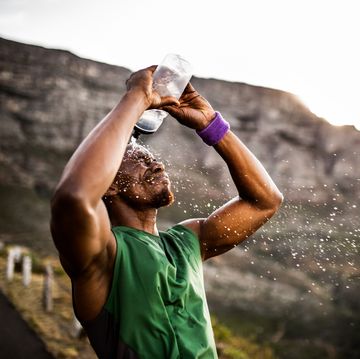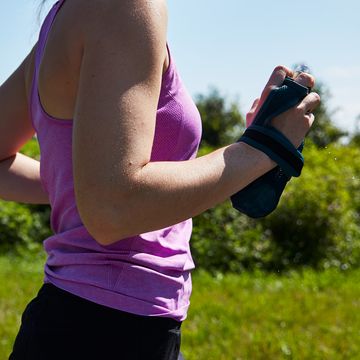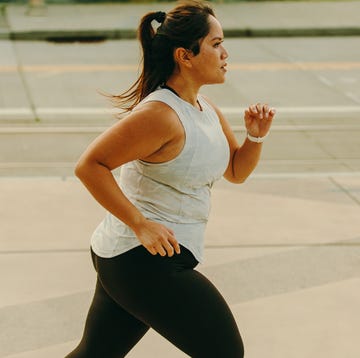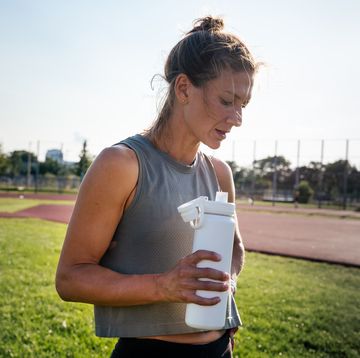Runners often obsess over weather reports, tracking the coolest time of day in which to run. But as anyone who's ever tried to finish a five-miler in steamy conditions knows, it's not just the temperature that matters, it's the humidity.
"Of all the climate measurements we take to assess heat risk for our runners, humidity is the biggest factor," says George Chiampas, D.O., the medical director of the Chicago Marathon. Humidity makes warm summer runs even more taxing because the higher the moisture content of the air, the hotter it feels. An 88-degree day with a relative humidity just under 40 percent, for example, will feel like 88 degrees. Hot, yes, but when humidity reaches 70 percent, that same 88 temperature feels like 100 degrees.
Unless you're lucky enough to live in Paradise, Nevada—the least humid city in the U.S.—here's how to cope when running in steamy conditions.
Why Humidity Matters
When you run, your core body temperature naturally rises, and your sweat glands produce droplets that carry excess heat to the surface of the skin, where it evaporates. But humidity prevents sweat from evaporating, so the heat stays put. "On a hot, humid day with no breeze, you have lost a key way to get rid of your building body heat, which can make running dangerous," says Michael Bergeron, Ph.D., a professor at the Sanford School of Medicine of the University of South Dakota.
If your body heats up and gets more and more dehydrated, it goes into survival mode, maintaining blood flow to your essential organs (to keep you alive) and to your skin (to regulate temperature). Less blood will flow to your GI tract, which will make the digestion of sports drinks or gels difficult, and you may feel nauseous as a result. You may also find you are more prone to side stitches when you are overheated—especially if your breathing becomes shallow and uneven. And your heart rate will escalate as your ticker and lungs work overtime trying to deliver oxygen throughout your body, Dr. Chiampas says.
But wait, there's (ugh!) more. If you continue to gut it out, your brain temperature will rise, which makes matters worse: Your ability to assess your own body temperature will become difficult (runners often report feeling chilled or goosebumpy when they're overheating). You can also start to lose control over body mechanics (your form and footing will get sloppy), and your mental abilities may start to break down (you may feel dizzy or disoriented).
"Your temperature can spike in minutes," Bergeron says. "If you're running a 5-K or a 10-K on a hot day, you can jack up your body temperature quickly." Also, it's a myth that newbies or not-fit-enough runners are the ones who suffer in hot, humid conditions. In fact, competitive athletes may be more prone to heat-related illnesses because the faster you run, the more body heat you generate. "As humidity increases, thermal strain and premature fatigue increase exponentially, and so running at your normal pace will feel very difficult," Dr. Chiampas says. It's also important to recognize that feeling sluggish on a sticky day doesn't indicate a lack of fitness or a lapse in mental toughness—it's your body's physical response to a stressful environment.
Of course, some people handle heat and humidity better than others. Body size is one factor—the more body mass you have, the more insulation and load you carry and the more heat your body generates, which makes it easier for you to overheat. Age is another variable—over time, your body becomes less adaptable to heat; age-related changes to sweat glands can decrease sweat production and reduce the body's ability to cool itself effectively. Also, sweat content varies: Some people lose more sodium in their perspiration than others, and that can impact performance and increase risk of cramps if these salty sweaters don't take in enough electrolytes. Where you live also plays a role: It takes generally 10 to 14 days to acclimatize to hot and humid conditions. People who train in humid parts of the country will become naturally used to muggy conditions and probably fare better at, say, an August East-Coast race than someone who travels in from the West Coast, where humidity is generally lower.
Slogging On
You might think the best times to run are early morning or evening, or cloudy, rainy, or not-crazy-hot days. But all of those can be incredibly humid. When you check the weather report, don't pay attention to just the temperature. The Heat Index combines temperature with relative humidity to give you apparent temperature—how it actually feels outside. Relative humidity doesn't become a factor until it reaches about 40 percent—below that, you'll have a comfortable run; above that, it could impact your performance. For example, a 75-degree day with zero percent humidity will feel like 69 degrees. But in 100-percent humidity, 75 degrees will feel like 80. (Though there is no simple formula for calculating Heat Index on your own, it's easy to find on weather Web sites and apps.) The National Weather Service issues a Heat Advisory when the Index is expected to exceed 105 for at least two consecutive days.
In those conditions, if you are intent on getting in a quality workout, your best bet is a treadmill in an air-conditioned room. Otherwise, opt for a shaded path (versus heat-absorbing roads), run close to water (bodies of water offer breezier conditions), and take walk breaks. It's essential to hydrate properly and let go of any time-based goals—run by feel instead of pace. When temperatures go from 75 to 90 degrees, heart rate can increase by 10 to 20 beats per minute, which will make your perceived effort much greater. Add humidity to the mix, and the effect will be even more significant, Bergeron says.
Be mindful of the early warning signs of heat exhaustion and heat stroke: fatigue, nausea, dizziness, headaches, tingly skin, and confusion. Call it quits if you experience any of them—even if you haven't reached the end of your run or the finish line yet.
The good news? You can teach your body to respond more efficiently in the heat. Signing up for a race in the second half of the summer will give you a few weeks of heat training under your fuel belt, so you'll struggle less than you would at the beginning of the season. And any training you do now will only make your fall runs all the more enjoyable.


